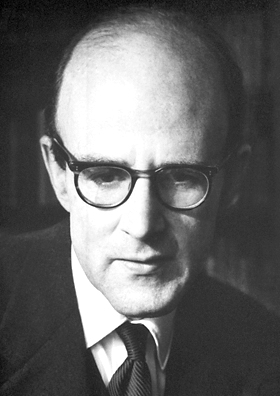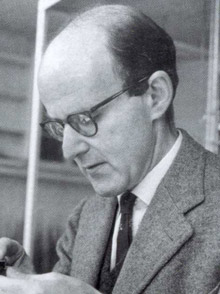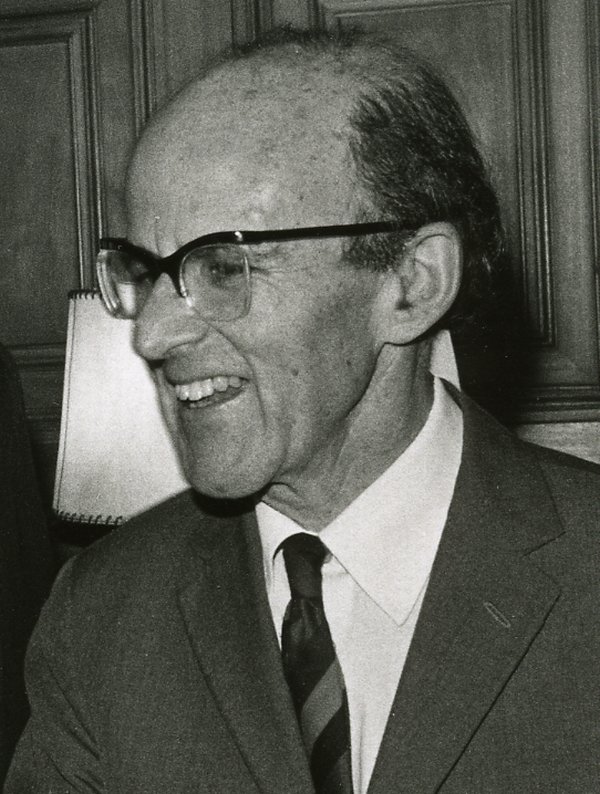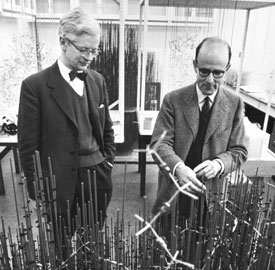<Back to Index>
- Molecular Biologist Max Ferdinand Perutz, 1914
- Painter Sarah Miriam Peale, 1800
- 5th President of Portugal João do Canto e Castro da Silva Antunes, 1862
PAGE SPONSOR



Max Ferdinand Perutz, FRS, OM, CBE (May 19, 1914, Vienna, Austria – February 6, 2002, Cambridge, United Kingdom) was an Austrian born British molecular biologist, who shared the 1962 Nobel Prize for Chemistry with John Kendrew, for their studies of the structures of hemoglobin and globular proteins. He went on to win the Royal Medal of the Royal Society in 1971 and the Copley Medal in 1979. At Cambridge he founded and chaired (1962 – 79) The Medical Research Council Laboratory of Molecular Biology, fourteen of whose scientists have won Nobel Prizes. Perutz's contributions to molecular biology in Cambridge are documented in The History of the University of Cambridge: Volume 4 (1870 to 1990) published by the Cambridge University Press in 1992.
In 1936, after completing his first university degree at the University of Vienna, Perutz became a research student at the University of Cambridge's Cavendish Laboratory, in a crystallography research group under the direction of J.D. Bernal. He completed his PhD. under William Lawrence Bragg. In Cambridge he started to work on haemoglobin, which was to occupy him for most of his professional career. As a research student Perutz became a member of Peterhouse, where he was elected an Honorary Fellow in 1962. He took a keen interest in the Junior Members, and was a regular and popular speaker at the Kelvin Club, the College's scientific society.
Perutz was exiled from Austria because of his Jewish heritage when Nazi Germany annexed that country prior to World War II. When the war did break out, he was rounded up along with other persons of German or Austrian background, and sent to Canada (on orders from Winston Churchill). During the war he worked on Habakkuk, a secret project to build an ice platform in mid-Atlantic, which could be used to refuel aeroplanes. To that end he investigated the recently invented mixture of ice and woodpulp known as pykrete. He carried out early experiments on pykrete in a secret location underneath Smithfield Meat Market in the City of London. Perutz had been engaged on this project because he had worked on the changes in the arrangement of the crystals in the different layers of a glacier before the War. After the War he returned briefly to glaciology. He demonstrated how glaciers flow.
In 1953 Perutz showed that diffracted X-rays from protein crystals could be phased by comparing the patterns from crystals of the protein with and without heavy atoms attached. In 1959 he employed this method to determine the molecular structure of the protein hemoglobin, which transports oxygen in the blood. This work resulted in his sharing with John Kendrew the 1962 Nobel Prize for Chemistry. Nowadays the molecular structures of several thousand proteins are determined by X-ray crystallography every year. Drug design in the pharmaceutical industry is largely based on the structural basis of the interactions of drugs pioneered by Perutz in the 1980s.
After
1959, Perutz and his colleagues went on to determine the structure of
oxy- and deoxy- hemoglobin at high resolution. As a result, in 1970, he
was at last able to suggest how it works as a molecular machine: how it
switches between its deoxygenated and its oxygenated states, in turn
triggering the uptake of oxygen and then its release to the muscles and
other organs. Further work over the next two decades refined and
corroborated the proposed mechanism. In addition Perutz studied the
structural changes in a number of hemoglobin diseases and how these
might affect oxygen binding. He hoped that the molecule could be made
to function as a drug receptor and that it would be possible to inhibit
or reverse the genetic errors such as those that occur in sickle cell anemia.
A further interest was the variation of the hemoglobin molecule from species to species to suit differing habitats and patterns of behavior. In his final years Perutz turned to the study of changes in protein structures implicated in Huntington and other neurodegenerative diseases. He demonstrated that the onset of Huntington disease is related to the number of glutamine repeats as they bind to form what he called a polar zipper.
During the early 1950s, while Watson and Crick were determining the structure of deoxyribonucleic acid (DNA), they made use of unpublished X-ray diffraction images taken by Rosalind Franklin, shown at meetings and shared with them by Maurice Wilkins, and of Franklin's preliminary account of her detailed analysis of the X-ray images included in an unpublished 1952 progress report for the King's College laboratory of Sir John Randall. Randall and others eventually criticized the manner in which Perutz gave a copy of this report to Watson and Crick.
It is debatable whether Watson and Crick should have been granted access to Franklin's results without her knowledge or permission, and before she had a chance to publish a detailed analysis of the content of her unpublished progress report. It is also not clear how important the content of that report had been for Watson and Crick's modeling. In an effort to clarify this issue, Perutz later published the report, arguing that it included nothing that Franklin had not said in a talk she gave in late 1951, which Watson had attended. Perutz also added that the report was addressed to an MRC committee created in order to "establish contact between the different groups of people working for the Council". Randall's and Perutz's labs were both funded by the MRC.
In his later years, Perutz was a regular reviewer/essayist for The New York Review of Books on biomedical subjects. Many of these essays are reprinted in his 1998 book I wish I had made you angry earlier. Perutz's flair for writing was a late development. His relative Leo Perutz,
a distinguished writer, told Max when he was a boy that he would never
be a writer, an unwarranted judgement, as demonstrated by Perutz/s
remarkable letters written as an undergraduate. They are published in What a Time I Am Having: Selected Letters of Max Perutz. Perutz was delighted to win the Lewis Thomas Prize for Writing about Science in 1997. Perutz attacked the theories of philosophers Sir Karl Popper and Thomas Kuhn and biologist Richard Dawkins in
a lecture given at Cambridge on 'Living Molecules' in 1994. He
criticised Popper's notion that science progresses through a process of hypothesis formation and refutation, saying that hypotheses are not necessarily the basis of
scientific research and, in molecular biology at least, they are not
necessarily subject to revision either. For Perutz, Kuhn's notion that
science advances in paradigm shifts that are subject to social and cultural pressures is an unfair representation of modern science. These
criticisms extended to scientists who attack religion, in particular to
Richard Dawkins. Statements which offend religious faith were for
Perutz tactless and simply damage the reputation of science. They are
of quite a different order to criticism of the demonstrably false
theory of creationism. He concluded that "even if we do not believe in God, we should try to live as though we did." Within days of the September 11 attacks in 2001, Perutz wrote to British Prime Minister Tony Blair,
appealing to him not to respond with military force: "I am alarmed by
the American cries for vengeance and concerned that President Bush's
retaliation will lead to the death of thousands more innocent people,
driving us into a world of escalating terror and counter terror. I do
hope that you can use your restraining influence to prevent this
happening."
In addition to the
Nobel Prize for Chemistry in 1962, which he shared with John Kendrew for
their studies of the structures of hemoglobin and globular proteins,
Max Perutz received a number of other important honors: he was appointed Commander of the Order of the British Empire in 1963, received the Österreichisches Ehrenzeichen für Wissenschaft und Kunst in 1967, the Royal Medal in 1971, the Copley Medal in 1979 and the Order of Merit in 1989.
